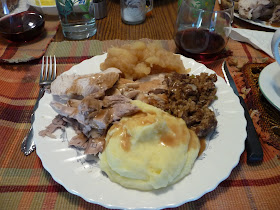 Gnocchi is a very old form of pasta, with some saying that it originated during the Roman Empire. However, the first written recipe for gnocchi dates back to the fourteenth century. It comes from a cookbook written in the Tuscan dialect. "Se vuoi i gnocchi, logli lo cascio fresco e pestalo; poscia toglia la farina et intridi con tourla d'uova a modo di migliacci." Or, as we would say, "if you want gnocchi, take some cheese and mash it, then take some flour and mix it with egg yolks as if you are making flour." Hundreds of years later, that still remains the basic recipe for gnocchi, with one noteworthy exception.
Gnocchi is a very old form of pasta, with some saying that it originated during the Roman Empire. However, the first written recipe for gnocchi dates back to the fourteenth century. It comes from a cookbook written in the Tuscan dialect. "Se vuoi i gnocchi, logli lo cascio fresco e pestalo; poscia toglia la farina et intridi con tourla d'uova a modo di migliacci." Or, as we would say, "if you want gnocchi, take some cheese and mash it, then take some flour and mix it with egg yolks as if you are making flour." Hundreds of years later, that still remains the basic recipe for gnocchi, with one noteworthy exception.
The "keystone ingredient" can be something other than cheese. Indeed, the most well known type of gnocchi is potato. This type of gnocchi is popular in the Italian regions of Lazio and Abruzzo, where potatoes are common. Other Italian regions have their own version of gnocchi, such as Malloredus, which is a Sardinian dumpling made only with semolina.
Gnocchi are traditionally a prima or first course. These dumplings can be served with a variety of sauces, such as a traditional red sauce, an Amatriciana sauce, a ragu or a brown butter sauce. For this recipe, which comes from Frank Stitt's Bottega Favorita, the gnocchi are served in a brown butter sauce and garnished with pieces of proscuitto.
GNOCCHI WITH PROSCUITTO AND SAGE
Recipe from Frank Stitt's Bottega Favorita at p. 119
Serves 6
Ingredients:
3 Russet potatoes (about 1 1/2 pounds)
2 Yukon Gold potatoes (about 8 ounces)
2 1/2 teaspoons of kosher salt
1 1/2 teaspoons of fresh ground white pepper
Freshly grated nutmeg
9 tablespoons of unsalted butter
About three cups of all-purpose flour
3 large egg yolks
12 medium sage leaves
6 thin slices of Proscuitto di Parma, cut into thin strips
1/4 cup of Parmigiano Reggiano, freshly grated.
Directions:
1. Preheat the oven at 350 degrees Fahrenheit. Place the potatoes on a baking sheet and bake until tender for about 1 to 1 1/2 hours. Let cook slightly.
2. Bring a pot of generously salted water to a rolling boil.
3. When the potatoes are cool enough to handle, peel them and place the warm (not hot) potatoes in a ricer. Add the salt, pepper, a grating of nutmeg, 3 tablespoons of butter and a handful of flour and press through the ricer onto a large cutting board or marble pastry board, Make sure the potato is not too hot, because it will cook the egg yolks. Using a fork, begin working in the egg yolks and remaining flour (you want an approximately equal volume of flour and potatoes). Using a pastry scraper or spatula to gradually incorporate the flour into the potato mixture. The gentler you are during this phase, the lighter the gnochhi will be.
4. Melt 2 more tablespoons of butter in a large saute pan and keep warm over low heat.
5. Divide the gnocchi dough into several pieces. Roll each one into a long 1/4 inch thick rope and cut into 1 inch pieces. Press each piece with the back of a fork to create ridges. Once they are all shaped, cook the gnocchi about 15 at a time. Drop them into the boiling water and then once they float to the surface, 30 seconds or so, remove them with a slotted spoon or skimmer and transfer them to the pan of melted butter. When all of the gnocchi are cooked and tossed in the melted butter, transfer them to a platter. (You can save the gnocchi to serve later by transferring the cooked gnocchi to an ice bath to cool rapidly and then place on a baking sheet and cover. Set aside for several hours at room temperature or refrigerate overnight.
6. Add the remaining 4 tablespoons of butter (or 6 tablespoons if you cooked the gnocchi ahead) to the saute pan and cook over medium heat until it melts and takes on a rich brown color, and gives off a nutty aroma. Add the gnocchi to the pan, add the sage, and toss to coat and heat through.
7. Serve the gnocchi on a warm plate, garnished with proscuitto and a sprinkle of Parmigiano Reggiano.
For more about the history of gnocchi, check out Anna Maria's Open Kitchen.
ENJOY!
For more about the history of gnocchi, check out Anna Maria's Open Kitchen.




























